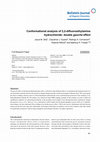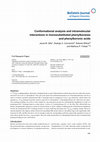Papers by Matheus Freitas

Beilstein Journal of Organic Chemistry, 2014
The gauche effect in fluorinated alkylammonium salts is well known and attributed either to an in... more The gauche effect in fluorinated alkylammonium salts is well known and attributed either to an intramolecular hydrogen bond or to an electrostatic attraction between the positively charged nitrogen and the vicinal electronegative fluorine atom. This work reports the effect of adding a fluorine atom in 2-fluoroethylamine hydrochloride on the conformational isomerism of the resulting 2,2-difluoroethylamine chloride (2). The analysis was carried out using NMR coupling constants in D2O solution, in order to mimic the equilibrium conditions in a physiological medium, in the gas phase and in implicit water through theoretical calculations. Despite the presence of σCH→σ*CF and σCH→σ*CN interactions, which usually rule the hyperconjugative gauche effect in 1,2-disubstituted ethanes, the most important forces leading to the double gauche effect (+NH3 in the gauche relationship with both fluorine atoms) in 2 are the Lewis-type ones. Particularly, electrostatic interactions are operative even ...

Beilstein Journal of Organic Chemistry, 2013
A 1TSJF,H(O) coupling pathway, dictated by a hydrogen bond, in some 2-fluorobenzoic acids has bee... more A 1TSJF,H(O) coupling pathway, dictated by a hydrogen bond, in some 2-fluorobenzoic acids has been observed, while such an interaction does not occur in 2-fluorophenol. Thus, this work reports the conformational analysis of 2-fluorophenylboronic acid (1), in order to evaluate a possible intramolecular OH∙∙∙F hydrogen bond in comparison to an nF→pB interaction, which mimics the quantum nF→σ*OH hydrogen bond that would be expected in 2-fluorophenol. 2-Fluorophenylborane (3), which does not experience hydrogen bonding, was used to verify whether nF→pB interaction governs the conformational equilibrium in 1 due to a predominant OH∙∙∙F hydrogen bond or to other effects. A series of 2-X-phenylboranes (X = Cl, Br, NH2, PH2, OH and SH) were further computationally analyzed to search for electron donors to boron, capable of influencing the conformational equilibrium. Overall, the intramolecular OH∙∙∙F hydrogen bond in 1 is quite stabilizing and dictates the 1hJF,H(O) coupling constant. Moreo...











Uploads
Papers by Matheus Freitas